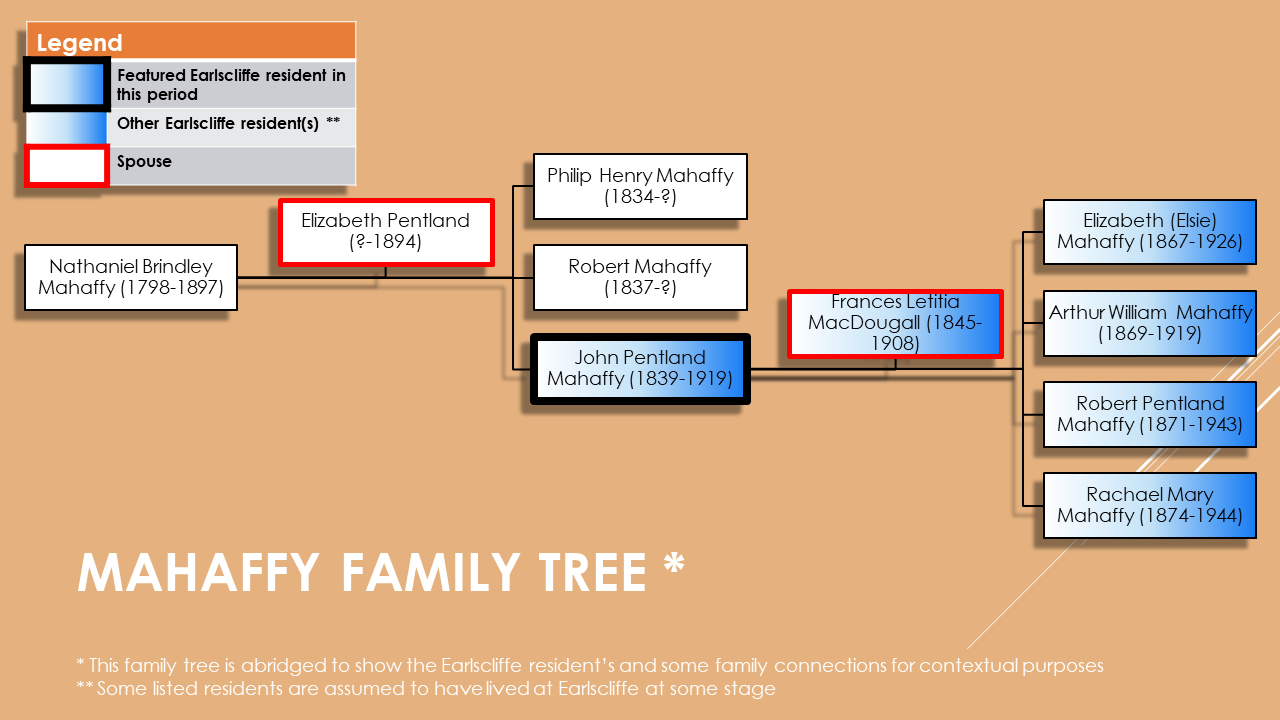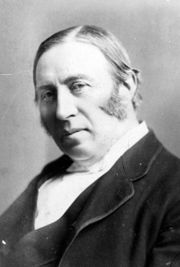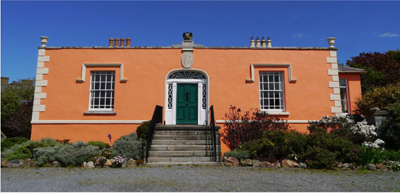History of the House / 1901 to 1922 - John Pentland Mahaffy
Previous / Next: 1896 to 1901 - John Randal Plunkett / 1922 to 1924 - CT Ovenden
Earlscliffe Residents 1901 to 1922
Earlscliffe house was purchased by Professor John Pentland Mahaffy in 1901. [1]
Professor John Pentland Mahaffy
The definitive book on Mahaffy describes describes him as follows:
Historian and philosopher, man of letters and musician, conversationalist and controversialist, sportsman, publicist, diner out and don (Wilde's tutor) - even among so versatile race as the Irish, and in an epoch so favourable to versatility as the Victorian, John Pentland Mahaffy was outstanding. Mahaffy became, long before his death, a legendary figure, the subject of many anecdotes, believable and unbelievable, and this book explores the contradictory and often extravagant legend. Mahaffy was a man much admired and much disliked; descriptions by friends and enemies range from near idolatry to sheer venom, and the authors show how these widely divergent opinions can be explained by conflicting elements in Mahaffy's own character and career. [2]
Family History

John Pentland Mahaffy was born in Chapponnaire, near Vevey, in Switzerland on the 26 Feb 1839. His father, Nathaniel Brindley Mahaffy, held a chaplaincy in Switzerland and when John was about four his parents moved to Kissingen in central Germany.

The Mahaffy income was derived from being 'absentee landlords', renting out their Monaghan estate. However, autumn 1845 saw the start of the Great Famine resulting in a fall in income for the Mahaffys, which only got worse over the next few years.
In 1848 revolution was sweeping through central Europe with rioting in a number of German cities. With falling income, and unrest in Europe, the Mahaffys decided that it was now time to return to Ireland.
The journey back was via Rotterdam with a stormy boat trip to Hull followed by a journey through England a a final boat journey from Liverpool to Kingstown (now Dún Laoghaire). It was a journey that Mahaffy recalled many times during his life. [2]
Spending his early years in Europe gave John a broad cosmopolitan outlook with a good knowledge of foreign languages [3] which certainly influenced his career going forward.
He graduated from Trinity College Dublin in classics and philosophy in 1859 and was elected Fellow in 1864. From then he started to publish papers and books. His first was on Kant, but then he turned to the history of Greece and by 1871 a chair of Ancient History was created for him.
In 1865 Mahaffy married Frances Letitia, daughter of William MacDougall who lived in Drumleck House in Howth.
Once married they moved to Dublin city and had four children.
Move to Howth

Mahaffy studied the meteorological records of the time and concluded that Howth had the highest average hours of sunshine of any point in Ireland, and very soon rented a summer residence called Sea Lawn on the Sutton side of the Howth Peninsula.[4] [5]
Mahaffy was tutor to Oscar Wilde, who described Mahaffy as his "first and greatest teacher". Oscar used to visit Mahaffy when he lived in Sea Lawn in Sutton. In 1876 Wilde wrote to William Ward:
I am with that dear old Mahaffy every day. He has a charming house by the sea here, on a place called the Hill of Howth, one of the crescent horns that shuts in the Bay of Dublin, the only place near town with fields of yellow gorse and stretches of wild myrtle, red heather and ferns...
-Oscar Wilde, 1876 [6]
A number of publications have mistook this as a quote about
Earlscliffe. However, 1876 was a full 25 years before Mahaffy
purchased the house.
Purchase of Earlscliffe
According to the book on Mahaffy by Stanford and McDowell, the story at the time was that his wife, Frances, bought Earlscliffe for Mahaffy from spare cash saved from her housekeeping money!
...tradition says that taking advantage of a fall in prices towards the close of the century she [Frances] steadily saved from her housekeeping money until she was able to present her unobservant husband with a seaside house [Earlscliffe] [2]
How true this is, nobody knows, but certainly Mahaffy would have been well paid at Trinity and would have earned royalties in Britain and America from the many books he had published.
It has also been said that Mahaffy had a reputation as 'an out-and-out snob'. For instance, it was noted that Mahaffy loved the nobility and would prefer the company of dukes and kings. When he moved into Earlscliffe as his second major residence, a wag at the time suggested that maybe it had better be renamed Dukescliffe! [2]
Mahaffy's children
Mahaffy had two daughters, Rachel Mary and Elsie, and two sons, Arthur William and Robert Pentland.
Rachel, the youngest daughter, was born around 1874. She loved botany and had a great knowledge of plants. [7] She contributed to the "Irish Naturalist" with sightings of rare plants spotted in and around the Earlscliffe estate. [8] She was also a good friend of the dramatist, George Bernard Shaw, who wrote to her and her father during the time they lived at Earlscliffe and North Great George's Street [9] , and afterwards when she lived in Sandymount in Dublin. [10] Rachel, who never married, was also a great supporter of her father, especially after her mother (Frances) died in 1908. [2] Rachel died on the 18 Jan 1944. [7]
In contrast to Rachel, Mahaffy apparently found his eldest daughter Elsie (Elizabeth) to be rather difficult. [2] She did, however, write a good account of the events in Trinity College during the rising of 1916 (see below). Her diary on this can still be found in Trinity College archives. [11] She, too, never married and died on 4 November 1926. [12]
The eldest Mahaffy son was Arthur William who was born in Howth on 22 Oct 1869. He was educated at Trinity College Dublin and at Oxford where he was a distinguished oarsman and went into the army. [13] In 1910 he was assistant to the high commissioner for the Western Pacific Islands [14] and rose to being the administrator of Dominica. [2] [15] He died in October 1919 [16]
The youngest Mahaffy son was Robert Pentland. He was born in 1871 [17] and graduated at Cambridge in 1893. He was called to the Bar in 1901 and was a barrister in London for some time. [18] In 1902 it was reported in the New York Times that he was engaged to Miss Beatrix Jones from the US. [19] However, we know that Robert never married Miss Jones as in 1904 he sailed from Liverpool to Ellis Island, New York with his father and it was recorded on the ships manifest that he was single. [20] He eventually married Hon. Evelina Victoria Dillon, daughter of Hon. Conrad Adderly Dillon and Ellen Lousia Dashwood, on 6 May 1919. [21]
In the first world war Robert Mahaffy served with The Devonshire Regiment and in the Egyptian Army and in 1920 was promoted major of The Royal Fusiliers (T.A.). He died on the 8th May 1943. [17]
Sport and the arts
Mahaffy loved shooting and fishing. He was also a skilful cricketer and adept at other field sports as well.
Another passion of his was music, especially Bach and Brahms.
He was a well travelled man, spending long periods in Greece, Africa and a number of trips to America. On his trips to Greece Mahaffy discovered two snowdrop species and named them after his daughters. The first was found on Mount Hymettus and he named it Galanthus Rachelae and the second found on Mount Athos he named Galanthus Elwesii. [22]
His famous wit
Mahaffy was regarded as one of Dublin's great wits. For example, when
he was looking for the role of Provost of Trinity College and he heard that the incumbent was ill,
he was said to have remarked, Nothing trivial, I hope?
Another example was when a suffragette confronted him and asked what was the essential difference between a man and a woman, he replied: Madam, I cannot conceive.
His political views
Mahaffy was a staunch unionist and pushed his political views through his work and his actions whenever he could.
In 1914, when Mahaffy finally became provost of Trinity College Dublin at the age of seventy-five (a role he had waited many years for), his political views now had some clout around the college.
For example, at this time, when Britain was at war in Europe, Pádraic Pearse was invited to speak at
a meeting to commemorate the birth of Thomas Davis, a Trinity
graduate who had made an outstanding contribution to the Irish
Nationalist tradition. Pearse was vocal at the time against
Ireland's participation in the war. When hearing he was going to
speak at the event, Mahaffy
stated that he would not allow Pearse a speaker with these to me traitorous views
to address the college unless he could be assured that Pearse said nothing
against enlisting in the imperial army.
In the end, he was so
stubborn about it that Trinity had to abandon the whole idea of the
commemoration. [2]
The 1916 uprising
On the morning of Easter Monday, 1916, Mahaffy was in the Provost's house in Dublin with his two daughters when news reached the front gate about the uprising. The porters locked the gate and told Mahaffy he should close the shutters on his house.
Because the British Army was quartered in Trinity, Mahaffy used to have the generals round for dinner where they would discuss the tactics for putting down the rebels and returning Dublin back to 'normality'.
All of this was captured in Rachel Mahaffy's diary of the uprising. [11]
When the end of the week came and the rebellion had been stopped, Mahaffy must have been pleased that the union was still in place.
Life for the Mahaffy's at the time they owned Earlscliffe
Mahaffy and his family only lived in Earlscliffe during the summer months, spending the balance of the year at his property at 38 North Great George's Street in the centre of Dublin.
Charity work
Mahaffy's wife, Frances, and their daughter, Rachel, were both contributors to charities. For example, at Christmas 1905, Frances gathered large donations from her friends for the 'Irish Distressed Ladies Fund'.[23] Also, in March 1906, Rachel got involved with the "Lend-a-Hand" club in Dublin. The club was was for "girls living at home who, although having many interests and amusements, nevertheless wish to do a certain amount of useful work for others less happily circumstanced than themselves." [24] Their work included entertaining patients in hospital, and working with temperance clubs and choirs.
Rachel was also Hon. Secretary of the Bethesda Female Orphan school on 67 Eccles Street in Dublin. This school was founded in 1784 for female orphans who were members of the Church of Ireland. According to an article in the Weekly Irish Times:
The girls are taken from the professional or better classes in the country, and every care given to their education and well-being, so as to fit them for any position in life they may choose to adopt.
-Weekly Irish Times, 29th Nov 1913 [25]
As part of this role, Rachel was present at a prize giving ceremony in February 1913 where the prizes were distributed by the Very Rev Charles Thomas Ovenden, Dean of St. Patrick's, and and future owner of Earlscliffe! [25]
During the first World War, Rachel and her father were involved in supporting and raising funds for the Dublin University Voluntary Aid Detachment (VAD) Emergency Hospital, where wounded soldiers from the war were treated. [26]
Travel
Mahaffy did a lot of foreign travel, sometimes with family members. For instance, in 1904, Mahaffy and his son Robert travelled together to go to the Congress of Arts and Science at St. Louis. Mahaffy paid for his sons trip. This was Robert's first time in the U.S., but Mahaffy had been there before (New York 1889). [20]
In 1907, the Irish Times reported that Mahaffy and his daughter, Rachel were off on a trip to Italy. [27]
Death of Frances Mahaffy
In 1908, Mahaffy's wife, Frances died and was buried in St. Fintan's Cemetery in Sutton. This was a sad time for Mahaffy who confided to a younger friend:
...for a youth like you to know what the rupture of a close intimacy of love and respect lasting nearly 43 years is to a man of declining years. I feel that in the deepest sense I have lost my home, and am henceforth a mere lodger in my own house. She was so sound in sense, tender in heart, large in sympathy. Many people loved her, all respected her.
-Mahaffy [2]
After the death of Frances, his two daughters remained with him and managed his house for him. [2]
Local dispute
As mentioned earlier, Mahaffy was known as a lover of music. However, his definition of music did not extend to the popular sound of music at the funfair!
In June 1913, a funfair was set up at Howth summit, consisting of "steam hobby horses, hurdy gurdy band, swing boats, rifle saloon, and other noisy and offensive amusements and variety show".[28] However, the one item that really got everyone's attention was a steam powered organ that produced "steam hooters" and "screaming ...whistles".
The locals put in an application for an interlocutory injunction to stop the fair and the noise which "continued every fine day until late at night, and the language of some of the persons gathered together by the show was most objectionable."
Gaisford St. Lawrence, owner of the Howth estate, said that when it was playing "it was difficult to read or attend to anything else, as it made a most penetrating and offensive noise."
An affidavit was put forward by Mahaffy who was described as having "a keenly sensitive ear for music". Mahaffy then went on to describe to the Counsel his view of the events "in language which counsel thought was very appropriate". Mahaffy said:
I, John Pentland Mahaffy, Senior Fellow of Trinity College, Dublin, and Chairman of the Howth Petty Sessions, residing at Earlscliffe, Howth, make oath and say: -There have recently set up close to Howth Summit, certain mechanical devices for the production of music by steam, to accompany hobby horses the music consisting of blasting, booming and clashing, with intermittent shrieks from whistles. This constitutes a grave nuisance to all the inhabitants, and will, if allowed to continue, have the effect or greatly depreciating the value of property in the neighbourhood. In my position as chairman of the Bench of Magistrates at Howth, I am enabled to state that serious complaints have been made by residents not only on account. of the nuisance caused by the noise, but also on account of the very undesirable crowd which is gathered by this hurdy-gurdy show.
The outcome of the case is not known.
1911 census
As mentioned above, Mahaffy only used Earlscliffe as a summer residence. This was shown in the 1911 Census of Ireland which was taken in April that year and does not mention Mahaffy or any of his family living in any property in Howth. However, the house named as "house number 1 in Censure (Howth, Dublin)" refers to Earlscliffe and Mahaffy is named as the landlord. The only occupants listed in the census were Thomas Meharry (the gardener) and his family: [29]
- Thomas Meharry (Husband), 33 years old, Gardener (Domestic), from Co. Cavan
- Margaret Meharry (Wife), 29 years old from Co. Meath
- Martha Jane Meharry (daughter), 3 years old, born in Dublin
- David T Meharry (son), 1 years old, born in Dublin
- Thomas Meharry (son), 8 months, born in Dublin
We must assume that the Meharry family were expected to manage the maintenance and upkeep of the Earlscliffe property over the winter months, leaving the Gardener's cottage as being listed as unoccupied. [29]
In that same 1911 census, Mahaffy's two daughters (Rachel and Elsie) were listed as living at North Great George's Street. However, their father was not listed at all. We assume that he must have been travelling at that time. [29]
Knighthood
In 1918, Mahaffy received the Knight Grand Cross of the Order of the British Empire, which was thought to be unusual as tradition was that a man in holy orders (he had been ordained as a clergyman) could not become a knight.
However, he wasn't Sir John for long as he died on the 30th April 1919 after a short illness and was buried with his wife in St. Fintan's Cemetery in Sutton. [2]
In the same month in 1919, Éamon de Valera, who had been briefly on the books at Trinity as a student in the early 1900s, was elected President of Dáil Éireann, the new republican assembly that claimed to be the legitimate government of Ireland. [3] Mahaffy wouldn't have been happy with that!
Earlscliffe after Mahaffy's death
After Mahaffy died, Earlscliffe house remained with the Mahaffy family for a few years more. The lease of Earlscliffe was renewed in 1922 with Howth Castle Estates for a period of 250 years by his daughter Rachel Mahaffy. [30]
Rachel Mahaffy finally sold the house in 1922 to the Very Rev. Charles Thomas Ovenden, the Dean of St. Patrick's Cathedral in Dublin. [30]
• •
List of Earlscliffe Residents
References
- [1] A History of the County Dublin, Francis Elrington Ball, originally published in six volumes (1902-1920). Volume 5 "Howth & its Owners" , Chapter 9 "As a Packet Station and After" https://archive.org/details/historyofcountyd05ball
- [2] John Pentland Mahaffy: Biography of an Anglo-Irishman, W B Stanford and R B McDowell, Publisher: Routledge & Kegan Paul Ltd, 1971, ISBN 0 7100 6880 8
- [3] Brief life story especially his academic career at Trinity College Dublin https://www.tcd.ie/provost/history/former-provosts/jp_mahaffy.php
- [4] Howth Through The Eye of the Artist, Vincent McBrierty, Publisher Trinity College Dublin Press, (2005), ISBN 1871408407
- [5] https://consult.fingal.ie/en/system/files/materials/4389/Howth-Mal%20-%20Building%20Structure%20-%20Prop%20Add.pdf retrieved on 21-Sep-2021
- [6] The Howth peninsula: Its history, lore & legend, Vincent J McBrierty, Publisher: North Dublin Round Table (1981) ISBN: 0950755303
- [7] Irish Times obituary for Miss Rachel Mahaffy, January 21, 1944 page 3 Also. https://probatesearch.service.gov.uk/Calendar/GetImgSrc?filePath=%2F1944%2FM%2F003598_maguire_1944.Png
- [8] The Irish Naturalist was an important scientific journal that was first published in April 1892. Rachel Mahaffy identified a number of plants that were native to Howth and were not included in the standard book on the subject, "Flora of Howth", by H. C. Hart, B. A., F.L.S. Dublin: published by Hodges, Figgis, and Co., 1887. See http://www.archive.org/stream/irishnaturalist04roya/irishnaturalist04roya_djvu.txt
- [9] As referenced in "A Bernard Shaw chronology" by Anthony Matthews Gibbs Published by Palgrave Macmillan, 2001 ISBN 0312231636, 9780312231637, page 227
- [10] As referenced in "Shaw: The Annual of Bernard Shaw Studies" by Fred D. Crawford Published by Penn State Press, 1998 ISBN 0271017791, 9780271017792, page 9
- [11] As referred to in http://www.tcd.ie/Library/manuscripts/collections/rebellions.php and https://www.tcd.ie/library/1916/elsie-mahaffys-record-of-the-rising/
- [12] Irish Times obituary for Miss Elizabeth Mahaffy, November 6, 1926, page 7. Also https://probatesearch.service.gov.uk/Calendar/GetImgSrc?filePath=%2F1926%2FM%2F002077_maginnis_1926.Png
- [13] See http://www.archive.org/stream/oxfordmen188018900fostuoft/oxfordmen188018900fostuoft_djvu.txt
- [14] See http://www.trussel.com/kir/gilbibm.htm
- [15] See http://www.worldstatesmen.org/Dominica.html and http://rulers.org/ruld.html
- [16] Irish Times obituary for Mr Arthur W. Mahaffy O.B.E., October 20, 1919, page 5
- [17] As reported in the London Times on the 10th May 1943, and quoted here: http://www.geneagraphie.com/getperson.php?personID=I188862&tree=1 Please note that the London Times obituary states that he was born in 1871. However, on the manifest for the ship S.S. Arabic quoted above for a journey taken in August 21, 1904 he is stated as being 36 years old.
- [18] "Mahaffy Descendants", Compiled by Estelle Kinports Davis and Mary E. Mahaffey Carst, HARRISBURG, PENNSYLVANIA, published in 1914, pp 144-167, as seen here: http://freepages.genealogy.rootsweb.ancestry.com/~bbunce77/Mahaffey8.html
- [19] New York Times, Aug 31, 1902 http://query.nytimes.com/mem/archive-free/pdf?_r=1&res=9901E1DC153DE433A25752C3A96E9C946397D6CF The full transcript is as follows: "From abroad comes the report of the engagement, which cannot now be verified, as Mrs. Jones and her daughter are abroad, of Miss Beatrix Jones, daughter of Mrs. Cadwallader Jones, and Robert Mahaffy, a son of John Pentland Mahaffy of Trinity College Dublin, Ireland. J. P. Mahaffy is well known as an author of various educational and other works, and is a member of many English and foreign societies. Miss Jones is a granddaughter of the late William Rawle of Philadelphia. Mrs Jones and her daughter sailed for Europe in June."
- [20] The manifest for the ship S.S. Arabic that arrived at Ellis Island from Liverpool on August 21 1904, can be found here: https://www.libertyellisfoundation.org Mahaffy and his son Robert travelled together to go to the Congress of Arts and Science at St. Louis. Mahaffy paid for his sons trip. This was Robert's first time in the U.S., but Mahaffy had been there before (New York 1889)
- [21] http://www.thepeerage.com/p3771.htm
- [22] As reported in the Irish Times "The Garden" section May 10, 1919 page 5 and pointed out to me by Peter Boyle, Fellow emeritus, TCD. As there are a large number of snowdrops in the grounds of Earlscliffe, we are currently looking out to see if these varieties can be found in the garden.
- [23] The donations to the Irish Distressed Ladies Fund were listed in the Irish Times, 15th Dec 1905. Out all of the many donations, it looks like Frances managed to get the largest donations (a whopping £50!) from a friend.
- [24] The 'Lend-a-Hand' club was discussed in the Irish Independent on March 20th 1906.
- [25] As reported in the Weekly Irish Times 29th Nov 1913, page 2.
- [26] The work of the Dublin University Voluntary Aid Detachment (VAD) Emergency Hospital was discussed in the Irish Times on May 19th 1915, page 7. A letter appealing for funds, signed by Rachel, was sent to the Irish Times on September 15th 1916, page 6.
- [27] As reported in the Irish Times, 24th March 1908.
- [28] As reported in the Freemans Journal 26th June 1913, page 8.
- [29] The National Archives of Ireland, Census of Ireland 1911, http://www.census.nationalarchives.ie/pages/1911/Dublin/Howth/Censure/20121/
- [30] Title deeds and other legal documents that are currently in the possession of Karen Foley
This page was last updated on 27-Jul-2023.
